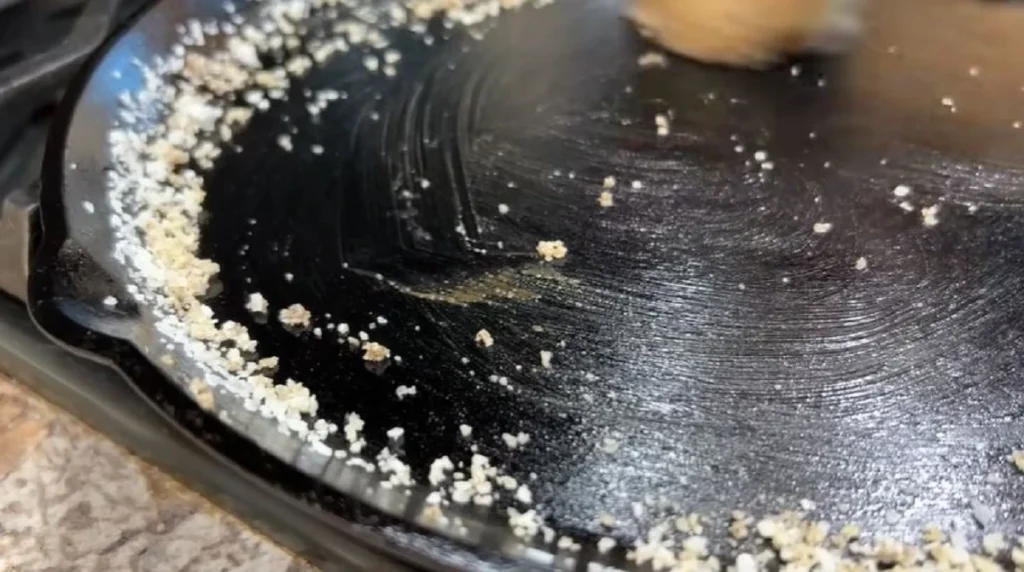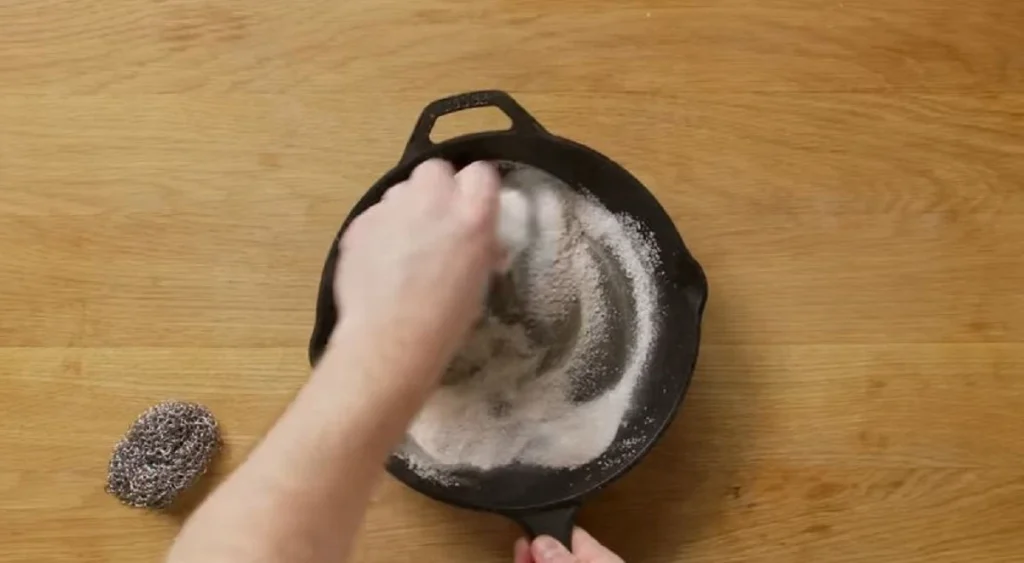A sticky cast iron skillet after seasoning is a common issue that perplexes many home cooks. This stickiness often results from excess oil left on the pan during the seasoning process. Seasoning, a critical step for maintaining cast iron cookware, involves baking oil onto the pan to create a natural, non-stick coating. The key to preventing stickiness lies in using just the right amount of oil and ensuring the pan is heated to the correct temperature.
One common mistake is applying the oil to a cold pan before heating. It’s vital to warm the skillet slightly before adding oil, ensuring the pores of the iron open and absorb the oil more effectively.
Another factor is the temperature at which the pan is seasoned. Too low a temperature fails to polymerize the fats effectively, leading to a tacky surface. Conversely, too high a temperature can cause the oil to burn, also resulting in a sticky residue.
The solution to a sticky skillet is straightforward. Place the skillet upside down in an oven preheated to 450-500 degrees Fahrenheit. Bake for about an hour, allowing the excess oil to cook off and properly polymerize. This process might need to be repeated if the stickiness persists.
Read Also: Easiest Way to Remove Rust From Cast Iron: 7 Steps
Why is Your Cast Iron Sticky After Seasoning?
Excessive Oil Use
One of the primary reasons for a cast iron skillet becoming sticky after seasoning is the use of too much oil. While seasoning, it’s essential to apply only a thin layer of oil. Excess oil doesn’t polymerize correctly and remains as a sticky residue. To prevent this, after coating the skillet with oil, wipe it down with a paper towel to ensure only a light layer remains.
Incorrect Heating Temperatures
Another crucial factor is the heating temperature during the seasoning process. If the skillet isn’t heated to a high enough temperature, the oil won’t fully break down and bond to the skillet’s surface, leading to stickiness. Ideally, the skillet should be placed in an oven at 450-500 degrees Fahrenheit for effective seasoning.
Inadequate Polymerization of Fats
The seasoning process involves the polymerization of fats, which creates a non-stick surface. If this process is incomplete, typically due to insufficient heating or uneven application of oil, the result can be a sticky surface. Ensuring even application and proper heating conditions is vital for effective polymerization.
Seasoning Technique Errors
Errors in the seasoning technique, such as uneven oil application, not heating the skillet long enough, or using inappropriate oils, can all lead to a sticky skillet. It’s important to follow a consistent and correct seasoning process, which includes cleaning the skillet, applying oil evenly, and heating it for the right duration at the correct temperature.

How to Fix Sticky Cast Iron?
Removing stickiness from a cast iron skillet after seasoning is a task that requires both patience and attention to detail. The goal is to restore the skillet’s smooth, non-stick surface without damaging the iron. Here are some effective methods:
1. Oven Baking Method
This technique involves baking the skillet to break down the sticky residue. Preheat your oven to 450-500 degrees Fahrenheit. Place the skillet upside down on the top rack, and bake for an hour. This process helps in polymerizing the oil properly, eliminating the stickiness. It may be necessary to repeat this step if the skillet remains sticky.
2. Salt Scrubbing Technique
For minor stickiness, a salt scrub can be effective. Heat the skillet slightly and sprinkle a generous amount of coarse kosher salt in it. Use a paper towel or a potato cut in half to scrub the surface gently. The abrasive nature of salt helps to remove the sticky layer without harming the underlying seasoning. After scrubbing, rinse with warm water and dry thoroughly.
3. Re-Seasoning Process
Sometimes, starting the seasoning process anew is the best option. First, clean the skillet using warm soapy water and a scrub brush to remove the sticky residue. Dry it thoroughly, then apply a thin layer of cooking oil. Heat the skillet in the oven as described in the oven baking method. This not only removes the stickiness but also rebuilds the seasoning layer.
Learn More: Best Metal Spatulas for Cast Iron
Unraveling Stickiness: Seasoned Cast Iron Skillet Woes
Excessive oil use, incorrect heating temperatures, issues with fat polymerization, and seasoning technique errors are often the culprits behind a cast iron skillet becoming sticky after seasoning. This stickiness is not just a minor inconvenience; it affects the skillet’s performance and longevity.
Using too much oil during seasoning can leave a sticky residue, as the excess oil fails to polymerize properly.
Similarly, if the skillet isn’t heated to the right temperature, the oil won’t bond effectively to the surface, leading to a tacky, uneven coating.
Moreover, incorrect seasoning techniques, such as applying oil unevenly or not heating the skillet long enough, can exacerbate this problem.
Solving the Sticky Situation: Restoring Your Cast Iron Skillet
To remedy a sticky cast iron skillet, various methods can be employed. Baking the skillet at a high temperature is a common and effective approach. This involves heating the skillet in an oven at 450-500 degrees Fahrenheit, which helps in breaking down the sticky residue and re-polymerizing the oil.
Managing the oil layer is also crucial; applying a thin, even coat of oil during seasoning can prevent stickiness. Cleaning methods such as using salt scrubs or mild detergents can also be effective in removing surface stickiness.
These oven-based solutions not only resolve the immediate issue of stickiness but also contribute to the skillet’s long-term maintenance, ensuring a smooth, non-stick surface for future cooking endeavors.
Proactive Seasoning: Preventing Stickiness in Cast Iron Skillets
Preventing stickiness in a cast iron skillet involves mindful seasoning practices. It starts with using the correct amount of oil – too much can lead to a sticky residue, while too little may not protect the pan adequately. The oil should be applied in a thin, even layer.
The temperature setting during seasoning is also vital; it needs to be high enough to polymerize the oil effectively. The timing of the seasoning process is equally important – the skillet should be left in the oven long enough for the oil to bond properly to the surface.
Proper preparation of the skillet, like cleaning and drying it thoroughly before seasoning, ensures that the oil adheres well, preventing future stickiness. These preventive measures are key to maintaining the longevity and functionality of your cast iron cookware.

Stickiness and Cooking: The Impact on Cast Iron Performance
Stickiness on a cast iron skillet can significantly impact its cooking performance. When a skillet is sticky, it can cause food to adhere to the surface, making cooking and cleaning more challenging. This stickiness can also affect heat distribution, leading to uneven cooking.
The efficiency of the skillet is compromised, as the non-stick properties of a well-seasoned cast iron are lost. Furthermore, this stickiness can even influence the flavor of the food, as bits of previous meals might stick and burn during cooking.
Cast Iron vs. Other Cookware: A Sticky Comparison
Comparing the stickiness issues of cast iron skillets with other cookware types, such as carbon steel pans and non-stick cookware, reveals some interesting contrasts. While carbon steel pans share similar seasoning requirements with cast iron, their response to stickiness can differ based on material properties and thickness.
Non-stick cookware, on the other hand, often avoids these stickiness issues altogether due to its synthetic coating but lacks the durability and heat retention qualities of cast iron.
Maintenance routines also vary significantly; cast iron requires regular seasoning, while non-stick pans often demand less intensive care. These differences in maintenance, durability, and user experience are essential for cooks to consider when choosing their cookware, as each type comes with its unique set of advantages and challenges.